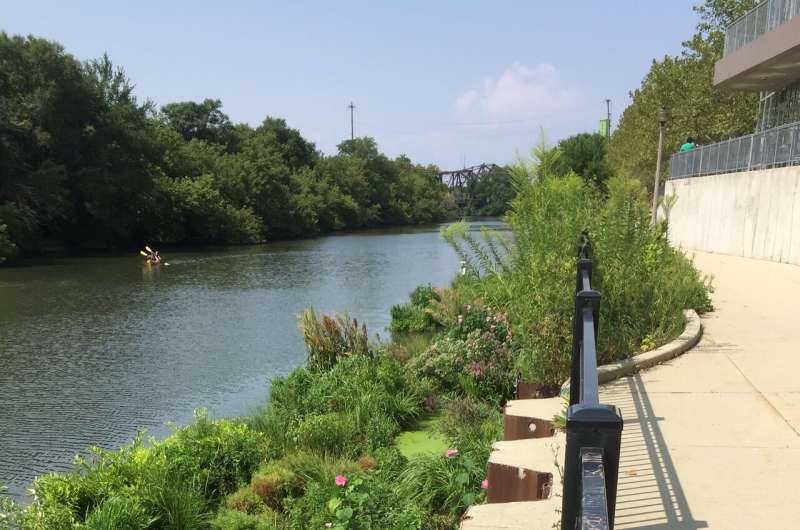Floating garden in summer. Credit: Abigail Heath.
Boulder, Colo., U.S.: Floating gardens sound so idyllic. Now, a study proves that they are more than just a pretty place. The study, by researchers at Illinois State University, demonstrates that such constructed gardens can have a measurable, positive impact on water quality.
Floating gardens are essentially rafts built on a frame of plastic caging, wrapped in coconut husks, and filled in with native plantings. As plants grow, they extend their roots into the water, growing hydroponically. On Chicago's North Branch of the Chicago River, non-profit Urban Rivers and partners are developing a mile-long, floating eco-park. Dubbed the Wild Mile, the re-development of this former industrial canal is Urban Rivers' flagship project. As part of the park, floating gardens, attached to shore, are being installed.
The primary intent of the floating gardens is beautification. But the Illinois State team, from the University's Department of Geology, Geography, and the Environment, saw an ideal setup for a controlled experiment. "We got involved because it's the perfect opportunity to see if there's an impact on water quality," explains lead author Abigail Heath.
Heath will present the results of the study in an online talk on Tuesday from 10:45 to 11:00 a.m. EDT, during the Geological Society of America's annual meeting.
Drone image showing setting and project surroundings. Credit Urban Rivers. Credit: Urban Rivers.
The study is novel: previous studies have explored floating gardens' impact on water quality over time, primarily in wastewater treatment ponds, but not over space, in moving water. The project also meshes well with Urban Rivers' broader goals. "The city is interested in water quality," says Phil Nicodemus, Urban Rivers Director of Research. "Happily, Illinois State got involved."
Starting in spring 2018, Heath and co-authors have sampled water immediately upstream and downstream of a narrow 3 meter by 50 meter floating garden installed along the shoreline. Samples are collected weekly, at the surface and from 0.3 meters deep, the depth where roots reach from the garden's base into the water. Although the garden is set at the edge of Chicago's urban core, water quality is also impacted by upstream agriculture. Analyses are focused on nutrients including nitrate as nitrogen, chloride, sulfate, and phosphate.
Could this small slice of human-made paradise improve water quality? An average of data collected over the course of the study show modest but definitive improvement. For example, nitrate as nitrogen dropped from 4.69 milligrams per liter in surface water just upstream of the garden to 4.43 milligrams per liter just downstream, a drop of about 1 percent. Phosphate was also lower downstream of the garden.
"Despite how small this garden was there was measurable improvement in water quality from upstream to downstream, especially for nitrates," notes Heath. She and colleagues see this as a scalable model for how larger floating gardens might help remediate water in similar settings. "Even this tiny garden makes a difference," she says.
More information: 60-4: Assessment of Floating Gardens to Improve the Water Quality of the Chicago River (10:45 a.m. EDT): gsa.confex.com/gsa/2020AM/meet … app.cgi/Paper/355783
Provided by Geological Society of America
























